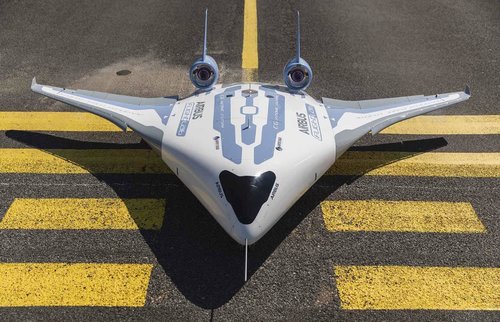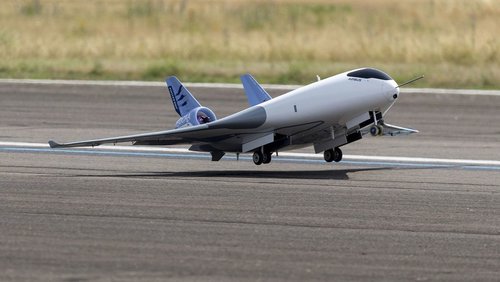bring_it_on
I really should change my personal text
- Joined
- 4 July 2013
- Messages
- 3,651
- Reaction score
- 3,781
https://www.youtube.com/watch?v=U3yR_-8p3ZY
AeroFranz said:Good stuff, thanks for posting the video
Pawlikowski had one big hole in her hope chest: funds to build a prototype blended wing, an elegant looking design the Air Force has been working on occasionally since at least 2008
interesting news but not a BWB, a hybrid wing.Airbus Unveils Blended Wing Body Demonstrator | Aviation Week Network
As it becomes clearer that disruptive new airliner configurations will be one of the few ways of meeting the reduced emissions targets of the future, Airbus has revealed it is flight-testing a scaled blended wing body (BWB) technology demonstrator.aviationweek.com



Can you elaborate the difference?interesting news but not a BWB, a hybrid wing.Airbus Unveils Blended Wing Body Demonstrator | Aviation Week Network
As it becomes clearer that disruptive new airliner configurations will be one of the few ways of meeting the reduced emissions targets of the future, Airbus has revealed it is flight-testing a scaled blended wing body (BWB) technology demonstrator.aviationweek.com
generally a BWB that is a wing w/ a uniformly thinning from the center all the way to the wing tip like the B-2. Hybrid is conformal body w/ wings attached like this Maveric.Can you elaborate the difference?interesting news but not a BWB, a hybrid wing.Airbus Unveils Blended Wing Body Demonstrator | Aviation Week Network
As it becomes clearer that disruptive new airliner configurations will be one of the few ways of meeting the reduced emissions targets of the future, Airbus has revealed it is flight-testing a scaled blended wing body (BWB) technology demonstrator.aviationweek.com
You consider the B-2 as an example of a BWB? I would think it is the classic example of a flying wing.generally a BWB that is a wing w/ a uniformly thinning from the center all the way to the wing tip like the B-2. Hybrid is conformal body w/ wings attached like this Maveric.Can you elaborate the difference?interesting news but not a BWB, a hybrid wing.Airbus Unveils Blended Wing Body Demonstrator | Aviation Week Network
As it becomes clearer that disruptive new airliner configurations will be one of the few ways of meeting the reduced emissions targets of the future, Airbus has revealed it is flight-testing a scaled blended wing body (BWB) technology demonstrator.aviationweek.com
If is walks like a duck, and quacks like a duck, it is a duck. The Maveric is the definition of a blended wing body design.generally a BWB that is a wing w/ a uniformly thinning from the center all the way to the wing tip like the B-2. Hybrid is conformal body w/ wings attached like this Maveric.Can you elaborate the difference?interesting news but not a BWB, a hybrid wing.Airbus Unveils Blended Wing Body Demonstrator | Aviation Week Network
As it becomes clearer that disruptive new airliner configurations will be one of the few ways of meeting the reduced emissions targets of the future, Airbus has revealed it is flight-testing a scaled blended wing body (BWB) technology demonstrator.aviationweek.com
We are not talking about ducks. Maveric's body and its wings are quite distinctly dijferent, it is not a BWB. Maveric looks nothing like the B-2.If is walks like a duck, and quacks like a duck, it is a duck. The Maveric is the definition of a blended wing body design.generally a BWB that is a wing w/ a uniformly thinning from the center all the way to the wing tip like the B-2. Hybrid is conformal body w/ wings attached like this Maveric.Can you elaborate the difference?interesting news but not a BWB, a hybrid wing.Airbus Unveils Blended Wing Body Demonstrator | Aviation Week Network
As it becomes clearer that disruptive new airliner configurations will be one of the few ways of meeting the reduced emissions targets of the future, Airbus has revealed it is flight-testing a scaled blended wing body (BWB) technology demonstrator.aviationweek.com
And a B-2 is not a BWB. It is the classic example of a flying wing.We are not talking about ducks. Maveric's body and its wings are quite distinctly dijferent, it is not a BWB. Maveric looks nothing like the B-2.
Can you provide details of the distinction between HWB and BWB, and who says so - especially who says so with any authority? For example you recently suggested the Airbus MAVERIC is a hybrid, though all the authoritative Airbus statements describe it as blended. On what grounds can you trump the authority of Airbus?There are hybrid wing bodies (HWB) and Blended Wing Bodies (BWB).
The term "flying wing" has a well established technical meaning and it does not include either of them, though it does embrace the B-2 - probably as the classic example due to its operational fame. Mind you, the term "hot rod" is pretty well defined too. I guess both phrases also share the property of being widely abused.Saying Flying Wing is like sayin my car is Hot Rod
you all are welcome to inaccurate definitions.Can you provide details of the distinction between HWB and BWB, and who says so - especially who says so with any authority? For example you recently suggested the Airbus MAVERIC is a hybrid, though all the authoritative Airbus statements describe it as blended. On what grounds can you trump the authority of Airbus?There are hybrid wing bodies (HWB) and Blended Wing Bodies (BWB).
This is a serious query, I am quite prepared to believe that there is a difference, as long as it has some weight of authority behind it. For example one might suggest that the traditional BWB may have a tail, while the more recent HWB is basically a tailless BWB - or whatever.
The term "flying wing" has a well established technical meaning and it does not include either of them, though it does embrace the B-2 - probably as the classic example due to its operational fame. Mind you, the term "hot rod" is pretty well defined too. I guess both phrases also share the property of being widely abused.Saying Flying Wing is like sayin my car is Hot Rod
So much B....So... opinion is divided then. Jsport says it's not a BWB. The rest of the world says it is. I can live with that.
you all are welcome to inaccurate definitions.

 arstechnica.com
arstechnica.com
A hybrid BWB (HWB) is commonly referred to as a BWB with an epennage

Airbus shows off MAVERIC, an unusual aircraft to test blended wing bodies
First the Flying V, now MAVERIC—are blended body designs really going to happen?arstechnica.com
A blended wing body (BWB), Blended body or Hybrid Wing Body (HWB) is a fixed-wing aircraft having no clear dividing line between the wings and the main body of the craft.[1] The aircraft has distinct wing and body structures, which are smoothly blended together with no clear dividing line.[2] This contrasts with a flying wing, which has no distinct fuselage. A BWB design may or may not be tailless.

Another problem is the safe location of the engines - you do not want a high, rear-mounted turbofan coming loose in a crash and smashing down onto the passenger cabin,
And of course there's the sheer practical issue of how do we dock this thing to a terminal....
The inevitable injuries and spilled drinks would lead to floods of lawsuits against the operators.
let's face it, if you were in a scenario where the engines might crash into the fuselage full of passengers, you are probably gonna die from what caused it, so it's a moot point.
I agree with you that some of the potential hazards may be being over-emphasised here, for example roof and floor hatches with built-in ladders have been proposed. But I report only a concern expressed by the official US regulator. Crash survivability is a major regulatory area and we are far less likely to die in a major landing or takeoff incident than our forebears.Steelpillow, let's face it, if you were in a scenario where the engines might crash into the fuselage full of passengers, you are probably gonna die from what caused it, so it's a moot point.
An uncontained blade loss, or worse, disc loss, is also more problematic in an over-fuselage engined BWB than a conventional layout - there's a much wide range of exit angles from the engine that take the debris through the fuselage.
The idea was dropped and, as had happened long ago with pusher vs. tractor propellers, the marginally less efficient wing was restored in preference to less efficient engines. BWB can be no different. In fact it is worse: with engines high and at the back, as a stall approaches the engine airflow will begin to break up, leading to the risk of compressor surge and major loss of power, just at the point the plane is most desperate for increased thrust. The BWB will thus draw itself into a superstall state in which it pancakes near-vertically and controls are ineffective.
The Westland Dreadnought Postal Monolane was a tailed BWB which flew briefly back in 1923, almost a hundred years ago. Although it was nominally a freighter, its windows show that it could accommodate eight passengers. For an airliner concept that has been investigated many times since then, there has to be a reason it is still as far from reality as ever. As I said, It can probably be done, but I am not convinced that it would be worth it.The most that has been tested is a scale model. No full scale rendition that has been subjected to the rigors of operational use. Just wind tunnel models, a few manufacturers mock-ups and a flying model or two. The basic concept is a long way off becoming reality.
The fact is, you have no idea as to whether the layout proposed by Airbus in the Maveric is less safe than a conventional one. None at all. There is no evidence out there that proves it either way, so for now, you are surmising based on what you know.
